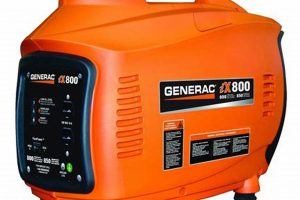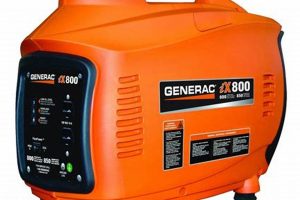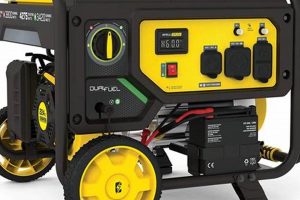Compact, gas-powered electricity sources designed for mobility and minimal noise output are increasingly popular for various applications. These devices offer a convenient power solution for recreational activities, job sites, and emergency backup power, minimizing noise disruption in sensitive environments.
The demand for low-noise power generation has grown due to noise pollution concerns and regulations in many areas. This technology benefits users by providing a more pleasant experience and allowing operation in noise-restricted locations. Advancements in muffler design, engine technology, and sound-dampening materials contribute to quieter operation without sacrificing power output. This evolution addresses the need for accessible power in various settings while respecting noise level constraints.
This article will explore the factors contributing to low-noise operation in these generators, including technological advancements, benefits for different use cases, and selection criteria for consumers. It will also discuss proper operation and maintenance for optimal performance and noise reduction.
Tips for Selecting and Operating a Low-Noise Generator
Choosing and using a generator designed for minimal noise output requires careful consideration of several factors. These tips offer guidance for maximizing quiet operation and ensuring a positive user experience.
Tip 1: Prioritize Decibel Ratings: Lower decibel (dB) ratings indicate quieter operation. Look for models with dB levels specified at a distance, such as 23 feet or 7 meters. Compare dB ratings across different models to make an informed decision.
Tip 2: Consider Inverter Technology: Inverter generators generally produce less noise and offer more stable power output compared to conventional generators. Their variable engine speed adjusts to power demand, leading to quieter and more fuel-efficient operation.
Tip 3: Evaluate Enclosure Design: Generators with well-designed enclosures and sound-dampening materials contribute significantly to noise reduction. Look for features like strategically placed vents and absorbent materials within the enclosure.
Tip 4: Proper Placement and Surface: Place the generator on a stable and level surface. Avoid placing it directly on hard surfaces like concrete, which can amplify noise. Using a rubber mat or vibration-dampening pad can help reduce noise transmission.
Tip 5: Maintain Proper Distance: Maintain a safe distance between the generator and any living or working spaces. Greater distance naturally reduces the perceived noise level. Utilize extension cords to power devices further away from the generator.
Tip 6: Regular Maintenance: Adhere to the manufacturer’s recommended maintenance schedule. Regular maintenance, including oil changes and air filter cleaning, ensures optimal engine performance and can contribute to quieter operation.
By following these guidelines, users can significantly reduce noise pollution and ensure a more peaceful environment when operating a generator. Proper selection and operation contribute to both user satisfaction and consideration for surrounding areas.
These practical tips offer a starting point for selecting and operating a low-noise generator. The subsequent sections of this article will delve deeper into specific generator types, features, and applications.
1. Sound-Dampening Technology
Sound-dampening technology plays a critical role in achieving quiet operation in portable propane generators. These generators, often used in noise-sensitive environments like campsites, RV parks, and residential areas during power outages, benefit significantly from noise reduction strategies. Sound-dampening involves a combination of techniques to minimize noise pollution, including specialized mufflers, strategically placed insulation, vibration-absorbing materials, and carefully designed enclosures. These components work in concert to absorb and dissipate sound energy, preventing it from radiating outward.
For instance, advanced mufflers utilize intricate internal chambers and baffles to disrupt the flow of exhaust gases, effectively reducing engine noise. Insulation, often composed of sound-absorbing materials like foam or fiberglass, lines the generator’s enclosure, further minimizing noise leakage. Vibration-absorbing components, placed strategically within the generator’s frame, dampen mechanical vibrations that can contribute to overall noise levels. The combined effect of these technologies results in significantly quieter operation, allowing users to enjoy the benefits of portable power without disturbing surrounding areas. This is particularly crucial in settings where noise restrictions are in place or where a peaceful environment is desired.
Effective sound-dampening technology represents a crucial factor in differentiating high-quality, low-noise portable propane generators. While engine design and operational strategies also contribute to noise reduction, sound-dampening components are essential for minimizing noise pollution. Understanding the function and implementation of these technologies allows consumers to make informed decisions when selecting a generator based on their specific needs and the sensitivity of the intended operating environment. This knowledge also highlights the engineering efforts dedicated to balancing power generation with environmental considerations.
2. Inverter System
Inverter systems play a crucial role in the quiet operation of portable propane generators. Unlike conventional generators that operate at a fixed speed, inverter generators adjust engine speed dynamically based on power demand. This variable speed operation significantly reduces noise output, especially during periods of lower power consumption. When less power is required, the engine slows down, resulting in quieter operation and improved fuel efficiency. Conversely, when demand increases, the engine speeds up to meet the load. This dynamic adjustment, controlled by the inverter system, optimizes both noise levels and fuel consumption.
Consider a scenario where a portable propane generator powers a campsite. With an inverter system, the generator can run quietly at a lower speed when only a few lights and small devices are in use. If a higher power demand arises, such as running a microwave or an electric grill, the inverter system seamlessly increases engine speed to accommodate the load. This adaptability ensures consistent power delivery while minimizing noise disruption compared to a conventional generator running continuously at a fixed, often higher, speed. This adaptive behavior results in quieter operation overall.
The incorporation of inverter systems in portable propane generators represents a significant advancement in noise reduction technology. This technology allows for more efficient and environmentally conscious power generation without compromising performance. The ability to adjust engine speed dynamically optimizes both noise levels and fuel consumption, making inverter generators a preferred choice for noise-sensitive environments. Understanding the function and benefits of inverter systems empowers consumers to select generators best suited for their specific needs and priorities, emphasizing the value placed on quiet operation.
3. Low-tone Muffler
Low-tone mufflers contribute significantly to the quiet operation of portable propane generators. Conventional mufflers often struggle to attenuate lower frequency sounds, which are perceived as particularly intrusive and travel further. Low-tone mufflers address this challenge through specialized design and construction. These mufflers incorporate features like larger expansion chambers, longer internal pathways, and strategically placed sound-absorbing materials to effectively target and suppress low-frequency noise generated by the engine’s exhaust. This targeted approach results in a more balanced and less disruptive sound profile, making these generators suitable for noise-sensitive environments. For example, a campsite or residential area benefits from the reduced noise pollution offered by a generator equipped with a low-tone muffler.
The effectiveness of a low-tone muffler depends on factors including its design, the specific characteristics of the engine, and the overall construction of the generator’s enclosure. Integrating a low-tone muffler into a well-designed enclosure further enhances noise reduction. Manufacturers often combine low-tone mufflers with other noise-reduction technologies, such as sound-dampening insulation and vibration-absorbing mounts, for a comprehensive approach to quiet operation. This multifaceted approach reflects a commitment to minimizing noise pollution while maintaining generator performance. Practical applications include powering sensitive electronic equipment or providing backup power in residential areas without causing undue disturbance.
In summary, low-tone mufflers represent a key element in achieving quiet operation in portable propane generators. Their specialized design addresses the challenge of attenuating low-frequency noise, contributing to a more pleasant and less intrusive sound profile. This technology, combined with other noise-reduction strategies, allows for practical power generation in various settings while minimizing environmental impact. Choosing a generator equipped with a low-tone muffler demonstrates consideration for both functionality and noise pollution concerns.
4. Engine Design
Engine design is a fundamental factor influencing the quiet operation of portable propane generators. A well-engineered engine minimizes noise and vibration at the source, contributing significantly to overall sound reduction. Several key aspects of engine design directly impact noise levels, including combustion efficiency, engine speed, and component balance.
- Combustion Efficiency
Efficient combustion reduces noise by minimizing unburnt fuel and pressure fluctuations within the cylinder. Modern propane generators often utilize advanced combustion systems that optimize fuel-air mixture and ignition timing for cleaner and quieter operation. This results in less explosive combustion and a smoother, quieter power delivery.
- Engine Speed
Lower engine speeds generally correlate with lower noise levels. Generators with larger displacement engines can produce the same power output at lower RPMs compared to smaller, higher-revving engines. This lower operating speed inherently reduces noise and contributes to greater fuel efficiency. Inverter generators further optimize engine speed by adjusting it dynamically based on power demand, leading to even quieter performance.
- Component Balance
Precisely balanced engine components, such as the crankshaft, pistons, and connecting rods, minimize vibrations. These vibrations, if left unchecked, can transmit through the generator’s structure and amplify noise. Careful balancing during manufacturing reduces these vibrations, contributing to quieter operation. This precision engineering is essential for minimizing noise pollution.
- Overhead Valve (OHV) Design
Many modern quiet portable propane generators utilize an Overhead Valve (OHV) engine design. This configuration places the valves in the cylinder head, leading to more efficient combustion and contributing to quieter operation compared to older side-valve engine designs. The improved combustion efficiency reduces noise generated by the explosion of the fuel-air mixture. OHV engines also tend to operate more smoothly, further minimizing noise and vibration.
These elements of engine design work in concert to minimize noise generation at the source. When combined with other noise-reduction technologies, such as sound-dampening enclosures and low-tone mufflers, the result is a significantly quieter portable propane generator. Choosing a generator with a well-engineered engine is essential for those seeking minimal noise disruption in various applications, including camping, RVing, and providing backup power in residential settings.
5. Enclosure Construction
Enclosure construction plays a vital role in the quiet operation of portable propane generators. The enclosure acts as the first line of defense against noise leakage, effectively containing sound generated by the engine and exhaust system. A robust and well-designed enclosure significantly contributes to reducing noise pollution. Several key factors in enclosure construction influence noise reduction:
- Material Selection: Dense, sound-absorbing materials such as thick steel, high-impact plastic composites, or multi-layered combinations effectively dampen noise. The material’s density and composition directly impact its ability to absorb and block sound waves.
- Structural Integrity: A rigid, tightly sealed enclosure minimizes vibrations and prevents noise leakage. Gaps or weak points in the structure compromise noise reduction efforts, allowing sound to escape. Reinforced corners and robust construction enhance the enclosure’s ability to contain sound.
- Internal Design: Strategic placement of sound-dampening materials, such as foam insulation or acoustic baffles, within the enclosure further absorbs and dissipates sound energy. This internal lining minimizes reverberations and reflections within the enclosure, reducing the amount of noise that escapes.
- Ventilation and Airflow: While a tightly sealed enclosure is essential for noise reduction, adequate ventilation is crucial for proper engine operation and cooling. Carefully designed vents and airflow pathways allow for sufficient ventilation while minimizing noise leakage. These vents often incorporate noise-reducing features, such as baffles or labyrinthine designs, to disrupt sound waves without restricting airflow.
For instance, a generator designed for camping might utilize a multi-layered enclosure incorporating sound-dampening materials and strategically placed vents. This design minimizes noise disruption without compromising engine performance or safety. Conversely, a generator intended for construction sites might prioritize durability and impact resistance, utilizing thicker steel or composite materials in its enclosure construction.
Understanding the impact of enclosure construction on noise reduction allows for informed decisions when selecting a portable propane generator. A well-designed enclosure is crucial for minimizing noise pollution and ensuring quiet operation in various environments. This knowledge highlights the engineering considerations involved in balancing functionality, durability, and noise reduction in portable generator design.
6. Operational Strategies
Operational strategies significantly influence the noise levels produced by portable propane generators. While the generator’s inherent design plays a crucial role, user practices during operation can further enhance quiet performance. Implementing these strategies contributes to a more peaceful environment and minimizes noise pollution.
- Placement and Surface:
The generator’s location and the surface on which it rests significantly impact noise levels. Placing the generator on a soft, absorbent surface like grass or dirt helps dampen noise compared to hard surfaces like concrete or asphalt. Additionally, positioning the generator further away from noise-sensitive areas and behind barriers like bushes or walls reduces perceived noise. For instance, positioning a generator behind a shed at the edge of a campsite minimizes noise disruption compared to placing it in the center of the campsite on a paved surface.
- Load Management:
Operating the generator at a lower load reduces engine strain and noise output. Avoid exceeding the generator’s rated capacity. Powering only essential devices and staggering their usage helps optimize load management. Running a refrigerator and a few lights produces less noise than simultaneously operating multiple high-wattage appliances like air conditioners or electric heaters.
- Maintenance:
Regular maintenance, such as oil changes, air filter cleaning, and spark plug replacement, ensures optimal engine performance and contributes to quieter operation. A well-maintained engine runs smoother and produces less noise than a neglected one. Following the manufacturer’s recommended maintenance schedule maximizes generator lifespan and minimizes noise output.
- Weather Protection:
Shielding the generator from rain and wind minimizes operational noise. A generator cover or a temporary shelter reduces noise generated by rain impacting the enclosure and mitigates wind noise. However, ensure adequate ventilation to prevent overheating. Proper ventilation maintains safe operating temperatures while minimizing noise caused by weather conditions.
By implementing these operational strategies, users can significantly reduce noise pollution and enhance the overall experience of using a portable propane generator. These practices complement the generator’s built-in noise reduction features and contribute to a quieter and more peaceful environment. Careful consideration of placement, load management, maintenance, and weather protection demonstrates a commitment to responsible generator operation and minimizes noise disturbance in various settings.
Frequently Asked Questions
This section addresses common inquiries regarding low-noise portable propane generators, providing concise and informative responses.
Question 1: How is the noise level of a portable propane generator measured?
Noise levels are typically measured in decibels (dB). Manufacturers often specify the dB level at a distance of 23 feet (7 meters). Lower dB ratings indicate quieter operation.
Question 2: What factors contribute to a quieter portable propane generator?
Key factors include engine design, muffler technology, enclosure construction, and the presence of an inverter system. Inverter generators generally operate more quietly than conventional models.
Question 3: Are inverter generators significantly quieter than conventional generators?
Inverter generators typically operate at lower and variable speeds, resulting in significantly quieter performance, especially at lower loads.
Question 4: How does enclosure design affect noise levels?
Enclosures constructed from sound-dampening materials and designed with strategic ventilation minimize noise leakage. A well-designed enclosure significantly contributes to quieter operation.
Question 5: Do operational practices impact noise levels?
Yes, proper placement, load management, regular maintenance, and weather protection can all contribute to reducing noise during operation.
Question 6: What are the benefits of a quieter generator?
Quieter generators minimize noise disruption in various settings, from campsites and RV parks to residential areas during power outages, allowing for more peaceful operation and compliance with noise regulations.
Careful consideration of these frequently asked questions empowers consumers to make informed decisions when selecting a low-noise portable propane generator. Understanding these aspects ensures a suitable choice based on individual needs and environmental considerations.
For further information on specific models and technical specifications, please consult individual product documentation and reviews.
Conclusion
Low-noise operation in portable propane generators results from a confluence of factors, including advanced engine design, efficient muffler technology, robust enclosure construction, and the integration of inverter systems. Sound-dampening materials, strategic ventilation, and vibration-reducing components further contribute to minimizing noise pollution. Operational strategies, such as careful placement, load management, and regular maintenance, enhance the effectiveness of these inherent design features. The convergence of these elements allows for practical power generation in noise-sensitive environments without compromising performance or convenience.
As technological advancements continue to refine these elements, portable propane generators promise increasingly quieter operation while maintaining power output and efficiency. This ongoing evolution underscores the importance of considering noise reduction as a key factor in generator selection, contributing to a more peaceful and sustainable coexistence of power generation and environmental preservation.






